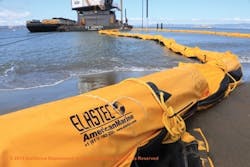About the author: Bob Crossen is associate editor for SWS. Crossen can be reached at [email protected] or 847.954.7980.
Runoff from storms at the new Presidio Parkway south of the Golden Gate Bridge in San Francisco was more than the storm drains could handle.
The new road contributed 8% more runoff. Sand buried a pipe outlet 6 ft deep due to tidal motion, and storm water spilled onto Mason Street and Crissy Field, deterring tourists from visiting the area. California Department of Transportation (Caltrans) officials generated solutions to the problem and wrestled with best practices for construction.
Within a construction window from March to October 2015, Caltrans replaced the pipe with little disturbance to the surrounding environment, which was a point of pride for the project team.
“Now people walk by that project area and there’s pretty much no evidence any work took place, which is—I think—the kind of thing you want on a project like this,” said Bob Haus, spokesperson for the Caltrans District 4 San Francisco Crissy Field Drainage Improvement Project. “No wildlife was harmed.”
Environmental Sensitivity
Much of the work on replacing the storm water infrastructure took place before any construction began. The plan required coordination between several agencies and 10 separate permit approvals.
The National Park Service (NPS), for instance, was particularly stringent on the construction window. Work on the beach portion of the project had to be completed by June 2015, and the rest of the project had to be finished by October. Conducting work outside that window, Haus said, could have disturbed mating seasons for certain species, which NPS hoped to avoid.
While ensuring compliance with regulations was time consuming, Kamran Nakhjiri, water pollutions control branch chief for Caltrans District 4, said it allowed the project coordinators to create detailed plans for the contractor.
“Sometimes we couldn’t get enough time to the contractor to prepare many of these plans, such as the stability monitoring plan, so ... we prepared ourselves in the design and included that in the contract package for the contractor to use,” Nakhjiri said. “And [we] had it approved by the water board and other agencies.”
Nakhjiri said the contractor also had an onsite laboratory to sample water. Measurements had to be taken four times per day to ensure water going back into San Francisco Bay was not contaminated.
“We were doing excavation within the San Francisco Bay, inside the bay, in the water. So we were making efforts to protect the water from turbidity,” Nakhjiri said. Finding a solution to the turbidity problem was not a simple task.
With minimal site disturbance, Caltrans replaced the pipe in a seven-month time frame. Right: The Caltrans team employed a custom turbidity curtain, which required constant monitoring. Image courtesy of the California Department of Transportation
Troublesome Turbidity
Nakhjiri and the project planners weighed three options when sorting through turbidity solutions.
A dry cofferdam using sheet piles to hold water away from the project area was determined ineffective. Maintaining a dry work area would have been difficult and there would not have been enough space to store the removed water.
Nakhjiri preferred the wet cofferdam method instead, but found it also was infeasible. While sheet pile still would have been used, the work space would have remained wet. The wet cofferdam method could trap wildlife within the work space without an outlet, requiring another permit and creating other problems for the project’s tight timeline.
“This could significantly delay and fail the project by not meeting the construction window provided to us, and that was a real challenge,” Nakhjiri said.
Instead, Caltrans used a custom turbidity curtain. A linear floating device holds the top at the water’s surface and anchors weigh the curtain down. A chain along the bottom kept it steady. The curtain was more malleable than a sheet pile wall, and the bottom could be raised and lowered with the tides. It fit in a smaller area—the excavation site was specifically targeted—which was ideal. Nakhjiri said the curtain also protected aquatic life.
“It has an 18-in. gap at the bottom. That 18-in. gap allowed marine animals, such as fish, to escape, so for that purpose, we didn’t need the harassment permit because we wouldn’t trap,” Nakhjiri said.
The curtain did, however, require constant monitoring. Elastec Inc., which designed and supplied the curtain for the project, provided consultants, who were on site to monitor the curtain during construction. With the onsite laboratory confirming the water was safe, the excavation was completed with the help of the turbidity curtain.
Pipe Fusion
To prevent damage from fusing the new storm water pipe on site, it was fused in a shipyard in the Hunter’s Point neighborhood.
“But when they did that, the pipe was too big to fit on any existing barges,” Haus said. “So they just floated it up. They attached it to a couple of tugboats and floated it on the bay all the way up to the site. That was something unusual, but it worked.”
Haus and Nakhjiri acknowledged the project forced Caltrans to think outside the box and use new materials like seapiles made from recycled plastic and fiberglass. The seapiles benefit the environment because they cut down on noise pollution and do not corrode.
The two saw the challenges and equipment design as a learning experience.
“We came up with a lot of ideas that worked, and chances are this won’t be the last time these ideas will be used,” Haus said. “This is something we can add to our body of knowledge on a lot of other projects coming up as well.”


